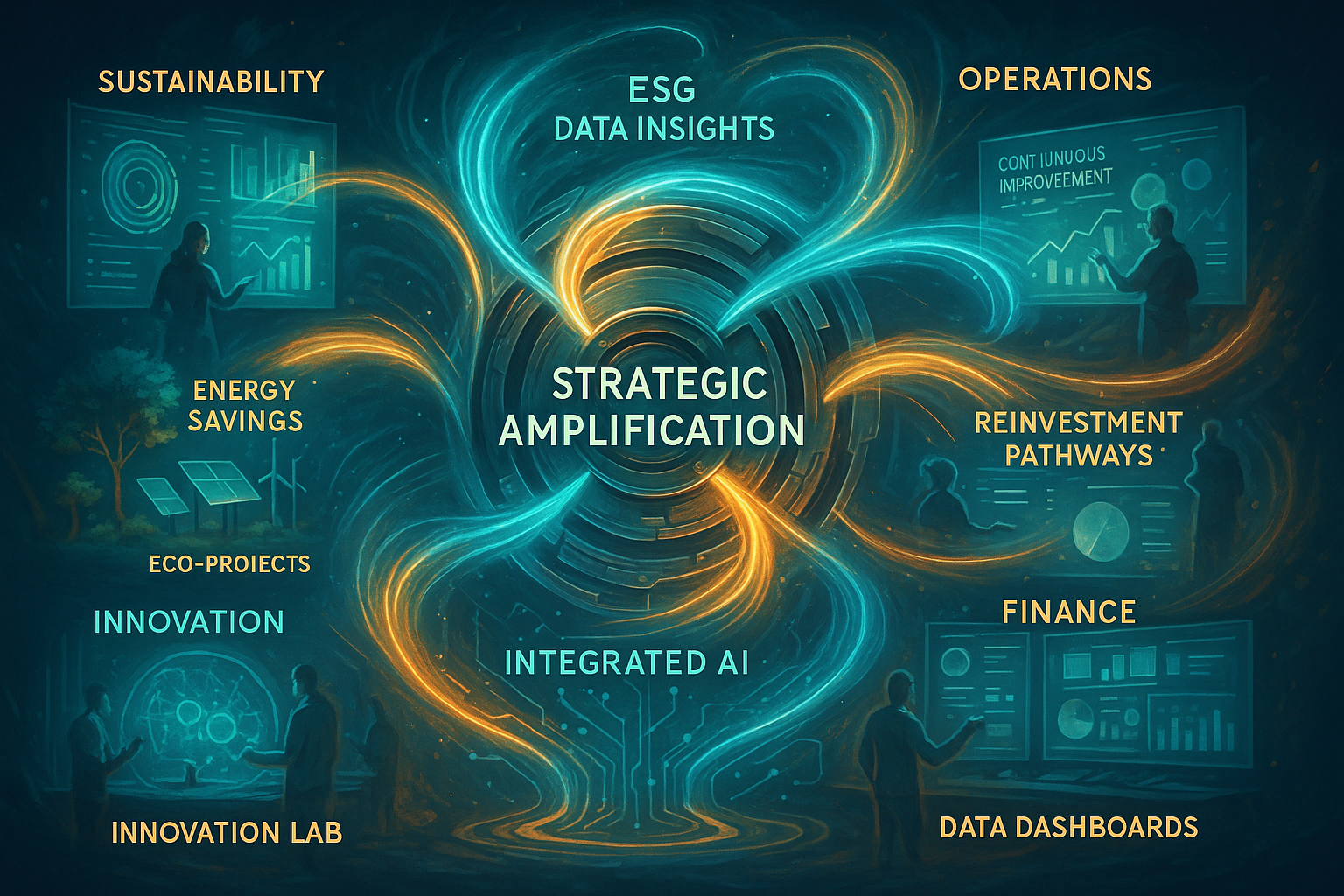The integration of Artificial Intelligence (AI) and sustainability delivers impact beyond isolated or minor improvements; its true power lies in strategic amplification, creating synergistic effects where the combined impact is significantly greater than the sum of its parts. Following our discussions on why this convergence is vital and how AI is being applied, this article explores the drivers that drive this multiplier effect, drawing exclusively from comprehensive research findings.
Strategically combining AI capabilities with sustainability objectives can trigger reinforcing cycles of impact, transforming how organizations approach and achieve their ESG goals. This isn’t an accidental byproduct but a result of deliberate integration that can lead to continuous improvement cycles and a deeper embedding of sustainability within the corporate DNA. We will now explore these synergistic dynamics and how early successes can be leveraged to fuel ongoing progress.
The Multiplier Effect: How Integration Creates Synergies and Chain Reactions
The strategic marriage of AI and sustainability initiates several reinforcing mechanisms that amplify impact across an organization. These mechanisms are evidenced in practice, not merely theoretical in companies leading the charge.
- Data-Driven Insights Fueling Enhanced Strategy: AI’s advanced capacity to analyze vast and complex ESG datasets uncovers patterns, risks, and optimization opportunities that traditional analysis might miss. These data-driven insights provide a more accurate and granular understanding of an organization’s sustainability footprint, enabling the development of more targeted, effective, and evidence-based sustainability strategies.
- Operational Efficiency Gains Funding Further Initiatives: A key synergy is the potential for tangible cost savings—generated by AI-driven efficiencies like reduced energy consumption or optimized logistics—to be strategically reinvested. These freed-up resources can then fund deeper sustainability projects or the development of new AI applications for sustainability, building a financially reinforcing cycle to the transformation. This reinvestment is a characteristic of organizations achieving significant AI-driven sustainability gains.
- Improved Measurement Enhancing Accountability and Performance: AI enables more accurate, consistent, and often real-time measurement and monitoring of key ESG metrics. This enhanced measurement capability increases transparency and strengthens accountability for sustainability performance across business units. The knowledge that performance is being accurately tracked often reinforces accountability culture for improvement.
- AI Enabling Scalability of Initiatives: AI provides the technological means to rapidly scale successful sustainability initiatives across the enterprise. For instance, an energy-saving pilot in one facility can be replicated more efficiently across multiple sites using AI-driven systems, achieving far greater impact than manual efforts would allow.
- Fostering Cross-Functional Integration and Holistic Solutions: AI can act as an integrating force, helping to foster interdepartmental collaboration. By consolidating and analyzing data from disparate functions (e.g., Operations, Supply Chain, Finance, Sustainability), AI can provide a holistic view of sustainability challenges, facilitating integrated solutions rather than piecemeal fixes.
- Catalyzing Innovation through Knowledge and Creativity: A link exists between AI capability, organizational creativity, and green innovation, ultimately driving sustainable performance. AI can enhance the sharing of green knowledge and cultivate a more creative climate focused on sustainability challenges. For example, Samsung integrates AI with lifecycle analysis in product design to drive eco-innovation, while Heineken uses AI-powered platforms to accelerate sustainable packaging development across teams. These cases reflect how AI-enabled creativity contributes to circular economy practices and sustainable product innovation.
- Creating Feedback Loops for Continuous Improvement: The deployment of AI systems generates data on their own performance and impact. This data can be fed back to refine algorithms and strategies, creating continuous improvement loops. However, these loops demand active governance, as biased AI outputs can create negative feedback loops if not detected and corrected.
 These synergistic effects are not automatic. Their realization depends heavily on strategic intent and deliberate organizational design. Leadership must consciously choose to reinvest savings, and collaborative structures must be established to achieve holistic solutions. Without this, AI applications risk remaining isolated point solutions, failing to unlock their full transformative potential. A “synergistic chain effect” can emerge, where initial successes build momentum and make subsequent initiatives easier and more impactful, creating a positive “flywheel” effect. However, negative feedback loops (e.g., from biased AI or AI’s own energy consumption) must be actively managed.
These synergistic effects are not automatic. Their realization depends heavily on strategic intent and deliberate organizational design. Leadership must consciously choose to reinvest savings, and collaborative structures must be established to achieve holistic solutions. Without this, AI applications risk remaining isolated point solutions, failing to unlock their full transformative potential. A “synergistic chain effect” can emerge, where initial successes build momentum and make subsequent initiatives easier and more impactful, creating a positive “flywheel” effect. However, negative feedback loops (e.g., from biased AI or AI’s own energy consumption) must be actively managed.
Fueling the Flywheel: Reinvesting Early Gains for Continuous Improvement Cycles
A core mechanism for amplifying sustainability impact lies in strategically reinvesting the gains from initial AI-driven initiatives. This establishes a reinforcing loop, or “flywheel,” where early successes fuel further progress.
The Reinvestment Loop – A Structured Approach: A structured approach can make this flywheel operational:
- Identify and Measure Early Wins: Focus initial AI deployments on areas with clear, quantifiable benefits (e.g., energy efficiency) and use AI’s analytical capabilities to accurately measure and document these gains.
- Quantify Financial Impact: Translate sustainability improvements into concrete financial terms (cost savings, value of reduced risk) to build the business case for reinvestment.
- Strategic Allocation of Gains: This critical step, requiring explicit leadership commitment, involves deliberately earmarking a portion of realized financial benefits back into the AI+Sustainability program. This can fund the expansion of existing applications, new initiatives, enhanced foundational capabilities (data infrastructure, AI tools, data governance), or talent development.
- Showcase and Communicate Success: Promote outcomes broadly, highlighting both sustainability outcomes and financial benefits, to cultivate organizational buy-in, justify further investment, and reinforce a culture of continuous improvement.
AI’s Role in Driving the Continuous Improvement Cycle: AI itself is a powerful enabler of this cycle:
- Accelerated Opportunity Identification: AI tools can rapidly analyze operational data to pinpoint new areas for optimization and sustainability improvement.
- Proactive Adjustments: Predictive analytics allow organizations to anticipate future problems or changing conditions and make proactive adjustments to maintain efficiency and sustainability performance.
- Ongoing Performance Monitoring: AI facilitates continuous monitoring and tracking of performance against evolving sustainability targets, providing real-time feedback for ongoing refinement.
While detailed end-to-end case studies of this specific reinvestment loop may not be prevalent, numerous examples of significant initial gains (like Google’s data center cooling savings or efficiencies in AI-driven agriculture) create the potential for such reinvestment. The critical factor is organizational commitment to completing the loop.
 A crucial warning emerges: the success of this flywheel is strongly influenced by the organization’s cultural norms and incentive models. If a culture prioritizes short-term financial extraction—focusing narrowly on quarterly results—over long-term sustainable value creation, efficiency gains are unlikely to be reinvested into further sustainability initiatives. The decision to reinvest hinges on strategic priorities and how performance is measured and rewarded. AI’s capabilities could even be used to optimize the reinvestment strategy itself, by modeling different scenarios and identifying pathways that generate the greatest amplification of sustainability impact.
A crucial warning emerges: the success of this flywheel is strongly influenced by the organization’s cultural norms and incentive models. If a culture prioritizes short-term financial extraction—focusing narrowly on quarterly results—over long-term sustainable value creation, efficiency gains are unlikely to be reinvested into further sustainability initiatives. The decision to reinvest hinges on strategic priorities and how performance is measured and rewarded. AI’s capabilities could even be used to optimize the reinvestment strategy itself, by modeling different scenarios and identifying pathways that generate the greatest amplification of sustainability impact.
Key Takeaways for Leaders
The exploration of strategic amplification provides vital insights for business leaders:
- The combination of AI and sustainability offers more than just additive benefits; it can create powerful synergies and positive feedback loops that multiply impact across the organization.
- Realizing this “multiplier effect” is not automatic. It requires deliberate strategic planning, including the conscious decision to reinvest early gains from AI-driven efficiencies back into further sustainability initiatives.
- Organizational culture, leadership commitment to long-term value (rather than purely short-term returns), and appropriate incentive structures are paramount to fueling this virtuous “flywheel” of continuous improvement.
- AI itself can be a tool not only for achieving initial sustainability wins but also for optimizing the reinvestment strategy and driving the continuous improvement cycle.
Conclusion: Harnessing Synergy for Transformative Change
The true transformative potential of integrating AI and sustainability lies in its ability to create synergistic chain effects. By strategically leveraging data-driven insights, reinvesting efficiency gains, and fostering a culture of continuous improvement, organizations can move beyond isolated successes to achieve a self-reinforcing cycle of positive impact.
This strategic amplification is what positions the integration of AI and sustainability from a series of tactical improvements to a fundamental driver of long-term value and competitive advantage. It requires foresight, commitment, and a willingness to design organizations that can harness these powerful feedback loops. The leaders who understand and actively cultivate these synergies will be best positioned to lead through 21st-century sustainability challenges and drive meaningful, lasting change.
In our next article, we will examine “The Maturity Curve,” to understand how an organization’s overall AI adoption maturity links directly to its success in achieving significant sustainability outcomes.
References
- PMI: Sustainability in the Age of AI – The Integration Imperative
A foundational reference cited repeatedly throughout the article. It clearly supports the themes of synergy, reinvestment, and leadership commitment.
https://www.pmi.org/-/media/pmi/documents/public/pdf/learning/thought-leadership/brightlinesustainabilityai20250403.pdf
- ResearchGate: Advancing Sustainability: ESG Evolution and the AI Edge
Provides evidence for data-driven insights, measurement enhancement, and the reinvestment loop—core to the “flywheel” logic in your article.
https://www.researchgate.net/publication/377455633_Advancing_Sustainability_ESG_Evolution_and_the_AI_Edge
- Emerald Insight: The Transformative Impact of AI on CSR, ESG, and Sustainability (Case Studies)
Strong academic basis supporting the feedback loop, innovation, and continuous improvement aspects of AI’s role in sustainability.
https://www.emerald.com/insight/content/doi/10.1108/s1569-376720240000023012/full/html
- National Law Review: Potential Opportunities and Risks AI Poses for ESG Performance
Balanced perspective covering both enablers and pitfalls—supports cautionary sections on feedback loop risks, measurement, and accountability.
https://natlawreview.com/article/potential-opportunities-and-risks-ai-poses-esg-performance
- ResearchGate: The Future of Six Sigma – Integrating AI for Continuous Improvement
Directly aligns with the article’s focus on feedback loops, process refinement, and continuous sustainability gains through AI.
https://www.researchgate.net/publication/384490633_The_Future_of_Six_Sigma-Integrating_AI_for_Continuous_Improvement
About the Author:
Sam Leung, Sustainability Community of Action (SCoA) Member
Merv Wyeth, Sustainability Community of Action (SCoA) Lead


